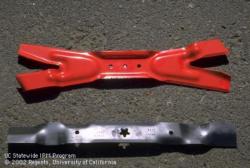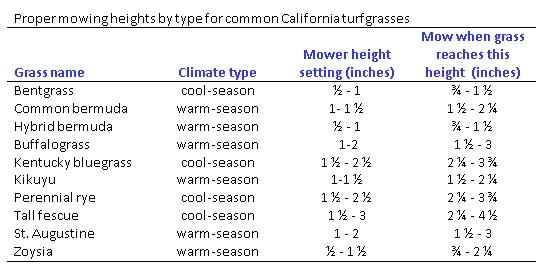Mowing and Grasscycling
Mowing: When and How?
Grass should ideally be mowed when the grass is DRY, but not stressed. If the lawn has been stressed by lack of water, irrigate and then allow to dry before mowing. Mower blades should be SHARP to minimize tearing of the grass blades which causes additional stress and a ragged appearance. No more than 1/3 of the grass height should be taken off at any one mowing.
How high?
Each grass species has its own ideal height range that yields the healthiest stand of turf. The table below tells you HOW HIGH. For each type of turfgrass, the tallest height in its range will yield the healthiest, most drought-tolerant grass. WHY?
- Taller leaf blades make more energy for the plant
- Taller blades are better at shading out weeds
- The taller the blade, the deeper the roots (more water uptake)

Grasscycling: What, Why, and How?
If grass clippings are distributed over a lawn rather than being bagged and carried off site, they sift down through the turf and break down, returning their nutrients to the soil. This is called GRASSCYCLING. Most of the greenwaste that goes to landfills is made up of grass clippings. A simple way to reduce this impact on our environment is to leave the grass clippings on the lawn. Since much of the fertilizer that is applied to lawns ends up in the leaf blades, it only makes sense to retain as much of that on the lawn as possible!
Significantly less nitrogen is needed on a lawn when grasscycling is used.
It may not be appropriate for all sports turf types, such as putting greens, to use grasscycling. However, for the majority of turf types, it is an effective way to cut down on maintenance and labor costs.
SUCCESSFUL GRASSCYCLING TIPS:
- Always use sharp mower blades made for mulching or finely cutting grass.
- Only mow when dry, or clumping will result, instead of even distribution.
- If grass does not distribute evenly, drive the mower over the clippings a second time to chop and scatter them.
- If grass has grown longer than its target mowing height (see Table below), do successive mowings of no more than 1/3 the height of the grass several days apart until the target height is reached.
If the clippings are too long or in large, damp clumps they will shade the grass rather than acting as a green mulch.
More information can be found in the Pubs and Websites below:

